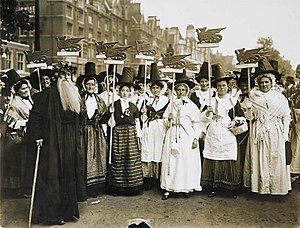Women's Coronation Procession
| Women's Coronation Procession | |||
|---|---|---|---|
| Part of first-wave feminism | |||
 Welsh suffragists in traditional dress | |||
| Date | 17 June 1911 | ||
| Location | 51°30′03.40″N 00°10′38.77″W / 51.5009444°N 0.1774361°W | ||
| Caused by | Fight for women's suffrage | ||
| Methods | Demonstrations, marches[1] | ||
| Parties | |||
| Lead figures | |||
Emmeline Pankhurst (WSPU) Prime Minister H. H. Asquith[1] | |||
The Women's Coronation Procession was a suffragette march through London on 17 June 1911, just before King George V's coronation, demanding women's suffrage in the coronation year. The march was organised by the Women's Social and Political Union (WSPU). It was "the largest women’s suffrage march ever held in Britain and one of the few to draw together the full range of suffrage organisations".[2]
Some 40,000 people marched from Westminster to the Albert Hall in South Kensington.[3] Charlotte Despard and Flora Drummond on horseback led the march, which included Marjery Bryce dressed as Joan of Arc and 700 women and girls clothed in white to represent suffragette prisoners.
Kate Harvey, Edith Downing and Marion Wallace-Dunlop were among the organisers, and Lolita Roy is believed to have been as well.[1][4] Jane Cobden organised the Indian women's delegation.[5]
The presence of a substantial number of marchers, both clergymen and lay women, under the banner of the Church League for Women's Suffrage was remarked upon by the Church Times.[6]
Elsie Hooper and other members of the National Association of Women Pharmacists joined the march. In June 1911 the Chemist and Druggist carried photographs of women pharmacists in the march and reported "Miss Elsie Hooper, B.Sc., was in the Science Section, and several other women pharmacists did the two-and-a-half hours’ march.”[7]
See also
References
- ^ a b c d Library, British. "Women's suffrage timeline - The British Library". Bl.uk. Retrieved 2018-02-26.
- ^ Saunders, Robert (26 October 2019). "'A Great and Holy War': Religious Routes to Women's Suffrage, 1909–1914*". The English Historical Review. doi:10.1093/ehr/cez360.
- ^ "Celebrating Elsie Hooper, early pioneer for women pharmacists, on International Women's Day". Pharmaceutical Journal. 8 March 2018. Retrieved 10 May 2018.
- ^ "Photograph of Indian suffragettes on the Women's Coronation Procession, 17 June 1911 at Museum of London". Museumoflondonprints.com. 1911-06-17. Retrieved 2018-02-26.
- ^ "Indian suffragettes in the Women's Coronation Procession". Museum of London. 19 October 2011. Retrieved 22 March 2013.
- ^ Saunders, Robert (26 October 2019). "'A Great and Holy War': Religious Routes to Women's Suffrage, 1909–1914*". The English Historical Review. doi:10.1093/ehr/cez360.
- ^ "Women pharmacists demand the vote". Wellcome Library. 13 October 2015. Retrieved 13 May 2018.
